
PREMIER League, OCTOBER 27 2024
Saka (9)
Merino (43)
Van Dijk (18)
Salah (81)
With Arsenal and Liverpool tipped as the most likely teams to contend with Manchester City for the Premier League title, a draw here meant two points conceded to the reigning champions. And yet both Mikel Arteta and Arne Slot could take positives from what was probably a fair result.
For the home team, there was the knowledge that they came close to defeating a title rival despite missing William Saliba through suspension, then losing Gabriel and Jurriën Timber to injury as the second half unfolded. From a Liverpool perspective, it may not have been another test entirely passed under Slot. In what should be one of their toughest fixtures of the season, though, it certainly was not failed either.
The fact that Liverpool were able to come from behind twice was something that pleased their Dutch manager. It wasn’t long after kick-off that Bukayo Saka got in behind Andy Robertson to lash home his 50th Premier League goal. That lead didn’t last long either, with Virgil van Dijk equalising from a corner within nine minutes, heading in a Luis Díaz flick on.
Arsenal dominated the rest of the first half and deservedly retook the lead, this time Mikel Merino heading in an excellent free-kick from Declan Rice. Liverpool were much improved after the break, as Arsenal defended deeper and made it difficult for the visitors to find space. It took a counter-attack to unlock the Gunners’ defence, as Mohamed Salah rounded off a swift move involving measured passing from Dominik Szoboszlai, Trent Alexander-Arnold and Darwin Núñez.
It was a closely fought encounter that our UEFA-licensed coaches have analysed, highlighting the key tactical points below…
How the managers saw it
“It’s disappointing not to win it because I thought we were the better team,” said Arteta. “We had the most domination, the biggest chances and without conceding anything really, we gave two goals away.”
“[Arsenal] played with a false nine, which they do maybe more often, but [before today] they didn’t come that many times with a full-back inside,” said Slot. “We could prepare them [the Liverpool players] at half-time a bit better from what we saw in the first half; we took some more risk [in the second half], but I think the main thing was we just put more energy into it. We pressed them more aggressive from the start.”
 221264523411119729626654263810111779
2212645234111197296266542638101117799/3
SHOTS / ON TARGET
8/3
46%
POSSESSION
54%
27
ATTACKS INTO AREA
27
1.53
EXPECTED GOALS (XG)
0.63
Winger threats
Both sides looked to find their wingers as efficiently as possible at the beginning of the match, with Saka and Gabriel Martinelli maintaining Arsenal’s width from their initial 4-2-3-1. Kai Havertz moved away from the traditional centre-forward spaces, leaving the hosts’ wingers as the highest players. With Liverpool initially defending in a 4-2-4 mid-block (below), central access for Arsenal was limited by Liverpool’s narrow front line. Spaces in behind were available, however, and Ben White’s long pass was superbly received and finished by Saka (below).
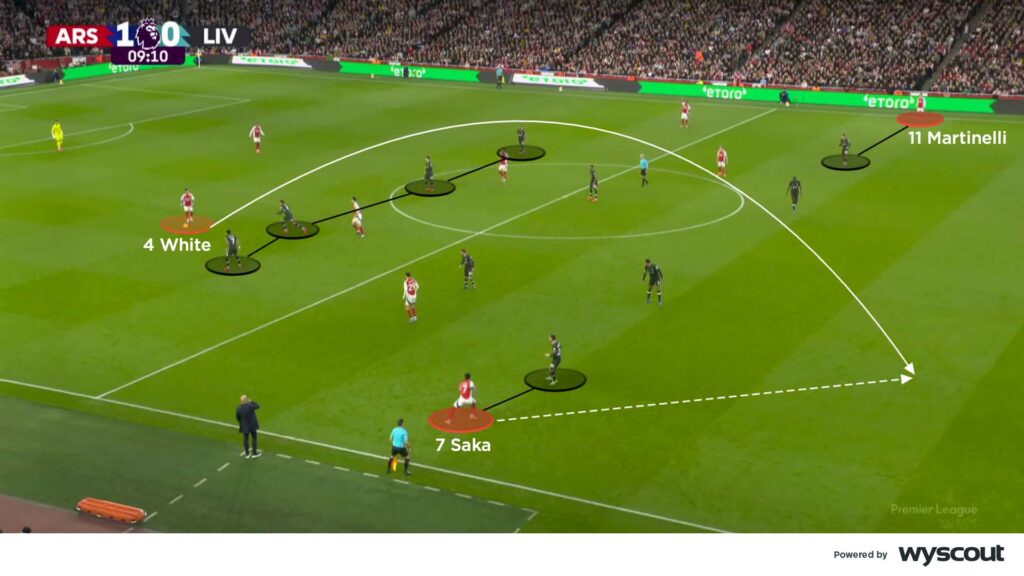
Although Arsenal utilised a different defensive shape – 4-4-2 – Liverpool also found it challenging to play through the middle of the pitch. Arsenal covered and screened the access available for Liverpool’s centre-backs to play out. With Núñez either overloaded or occasionally dropping into midfield, Salah and Díaz became the main threats in behind. Arsenal’s makeshift right-back Thomas Partey was challenged by direct passes into space for Díaz to run on to (below). On the opposite side, balls into Salah – up against Timber – helped him pin and secure possession, before connecting with the advancing Alexander-Arnold from deep.
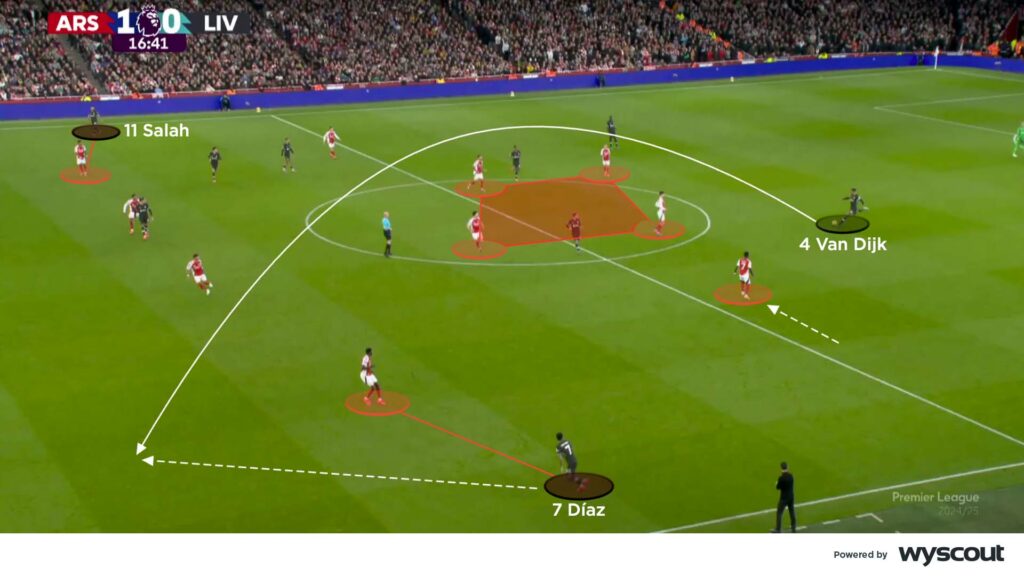
Arsenal’s wide support
Arsenal found their passing rhythm against Liverpool’s block midway through the first half. Havertz fully committed to moving into a wide role, right underneath Saka (below). This movement helped Arsenal build from side to side, which was enhanced by central-midfield rotations, not least Trossard dropping. Double pivots Rice and Merino readjusted, creating support and passing connections into Martinelli, so that Arsenal could get their wingers in regular 1v1s against Liverpool’s full-backs.
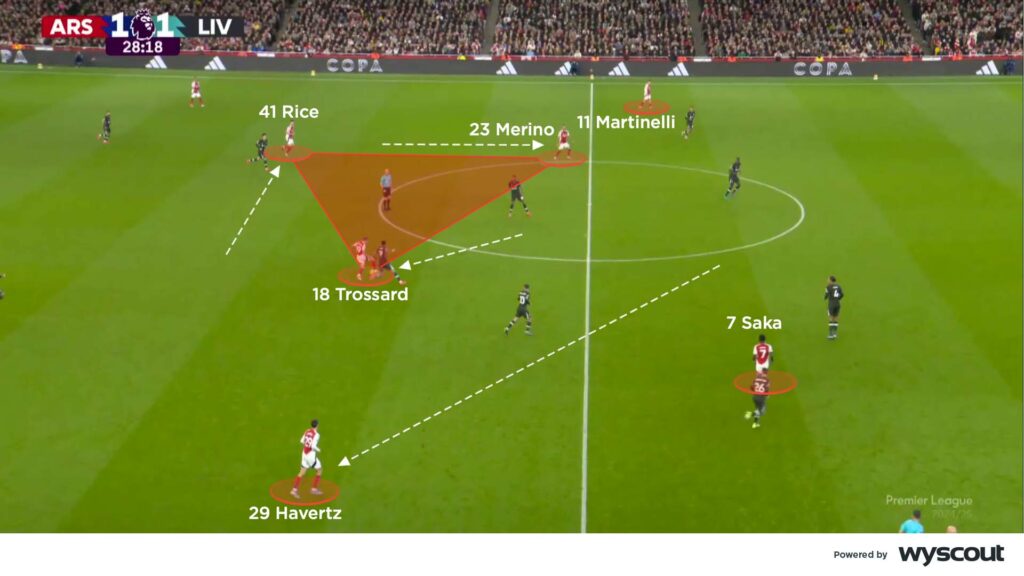
It was Saka who remained Arsenal’s key threat from their wide play as the first half progressed. Havertz’s positioning created passing connections similar to those provided by Merino on the other side, but also prevented Saka from receiving underloaded. With Díaz having to deal with Havertz, Saka was often able to attack Robertson 1v1 (below). Saka’s trademark run back inside helped him to receive facing forward, before progressing into the final third with real purpose. Partey’s movements inside also gave Arsenal central numbers, to maintain possession or to work play to the left for Martinelli to attack. Arsenal’s threatening wide play and pressure eventually told, when they deservedly retook the lead via a set-piece.
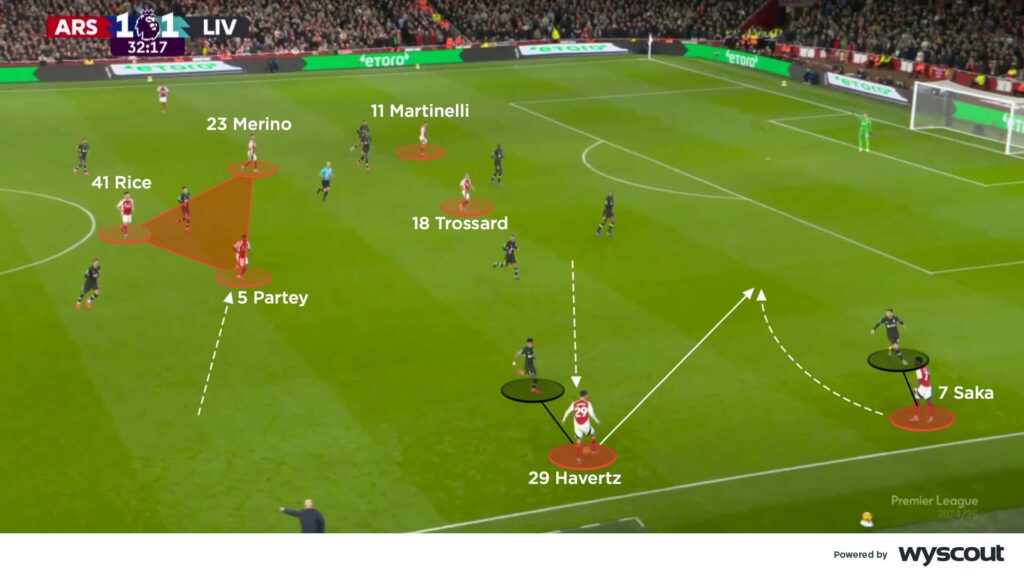
Liverpool’s pressing and wide combinations
Liverpool’s reaction to Arsenal’s first-half dominance was impressive, and they became the stronger of the two teams as the second half progressed. Slot shifted their defensive strategy, getting his team to press higher more frequently. Jones and Núñez jumped on to Arsenal’s centre-backs when they received in deep positions and, where possible, pressed on to goalkeeper David Raya. As one of the front line curved their press, the other remained narrow to stop central passes through, while the far-side winger narrowed to stop reversed passes back inside (below). Arsenal subsequently lacked the possession and passing sequences of the first period, and were unable to find the widening Havertz, or get Saka 1v1 as often against Robertson.
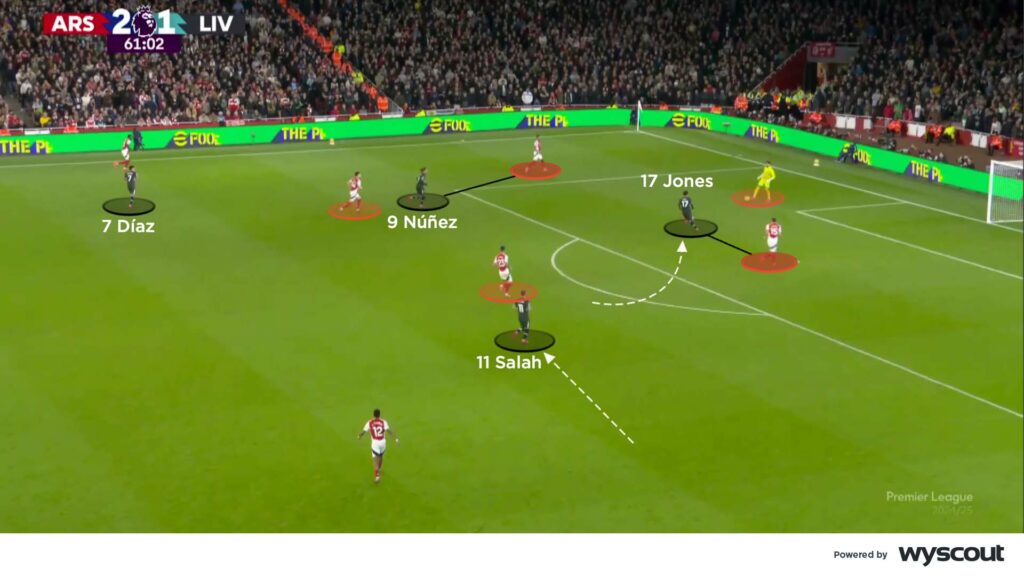
Liverpool were not only nullifying Arsenal’s build-up, but also dominating possession. As a result, Arsenal dropped into a 4-4-2 low block to deal with the visiting team’s momentum. As the second half progressed, Liverpool’s wide areas became significant, with their winger, full-back and number-eight combinations causing problems either side of centre-forward Núñez. This was exacerbated by Arsenal’s enforced back-line changes, with Jakub Kiwior replacing Gabriel after 54 minutes, and 18-year-old Myles Lewis-Skelly introduced after 76 minutes for Timber.
On Liverpool’s right, Salah narrowed to allow Alexander-Arnold to supply crosses, with Szoboszlai providing late runs into the box. On their left, providing similar returns were Cody Gakpo and Kostas Tsimikas, on for Díaz and Robertson after 63 minutes. This pair supported around Jones, who was moved into a more useful number-eight role (below).
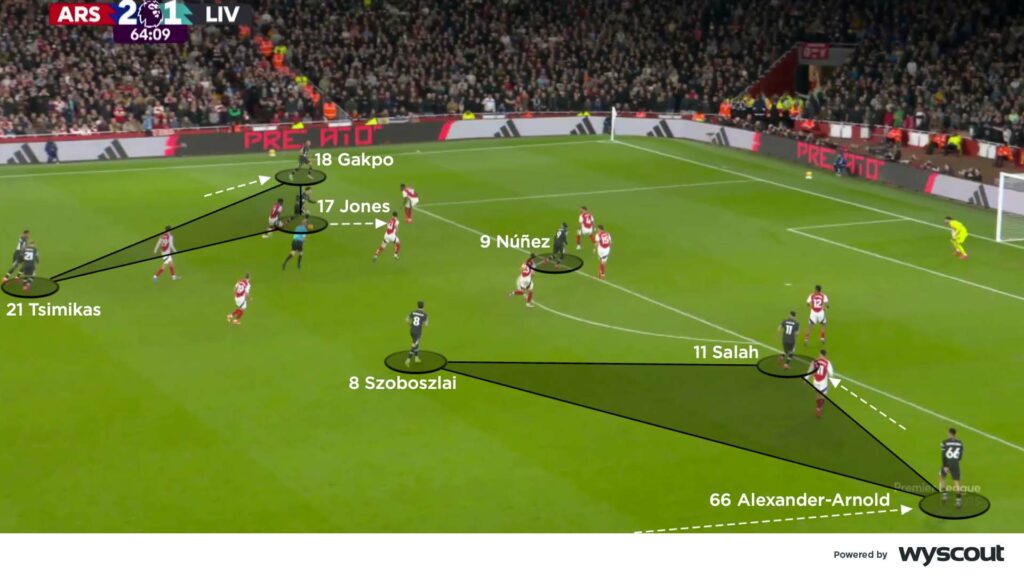
With Arsenal starting to push forward again as the game reached its latter stage, Liverpool took full advantage of the space available. On the counter, Alexander-Arnold found Núñez with a bending ball into the wide right space, who squared for Salah’s deserved equaliser. Neither team were able to find a late winner, meaning both could take positives and negatives from a game where perhaps only Manchester City were truly pleased with the result.
To learn more from professional coaches at The Coaches’ Voice, visit CV Academy


